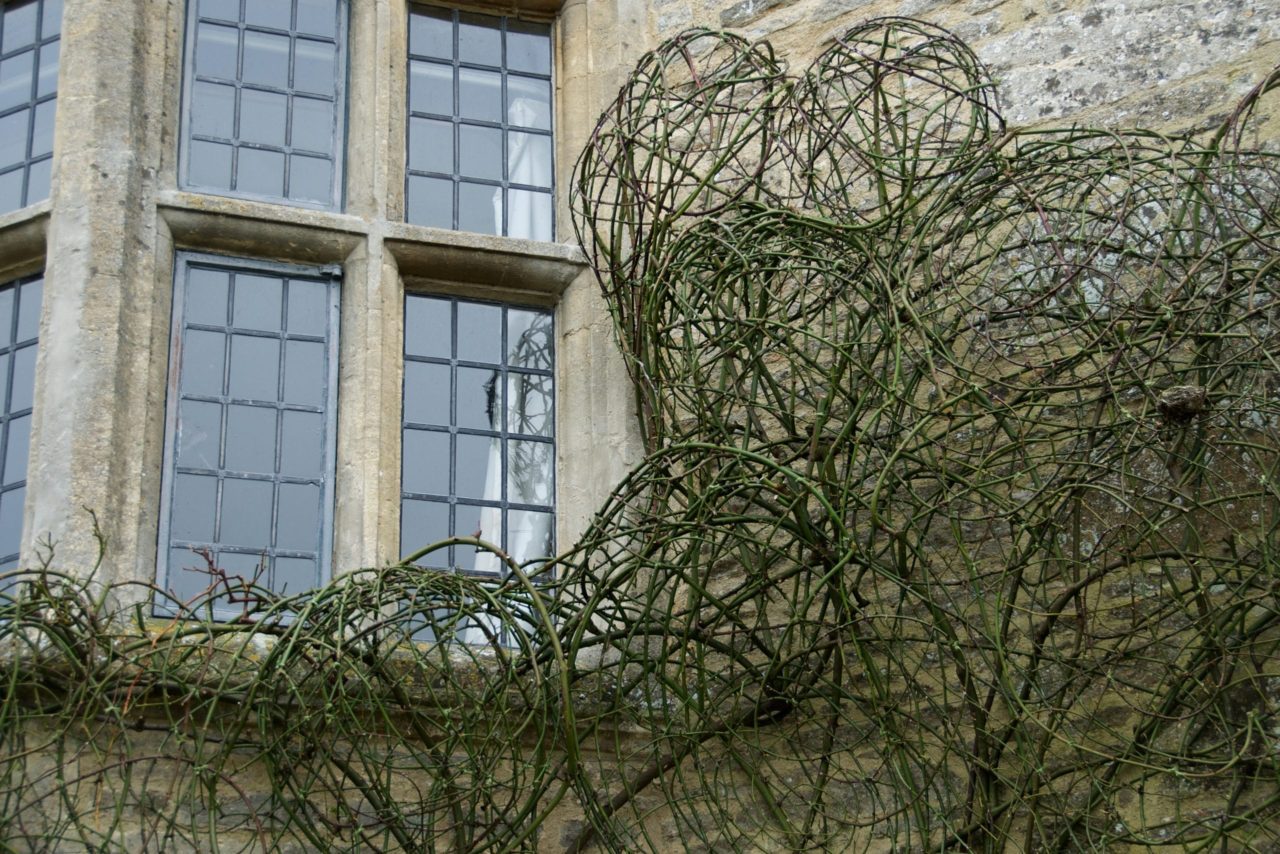When it comes to following rules, I’m pretty much, Dutch. Unspoken or rules carved in stone, there’s an efficiency in rule following, so we clog wearing folk happily fall into line. When the mighty Royal Horticultural Society therefore prescribes that good pruning policy requires me to swiftly decapitate a crossing/rubbing branch, I don’t argue. Off with its head. Yet, imagine my surprise seeing that the crossing/rubbing branch can be part of something so much more delightful than my compost bin. At Asthall Manor in Oxfordshire, the crossing branch is celebrated, embroidered, twisted, and shaped into wondrously bulbous geodesic shapes that adorn the house and garden. No sign of disease, distress or weakened plants, rather healthy, vigorous climbers that’d give Sir Edmund Hillary a run for his money.
Year of the twig
Dormant they may be, but the climbers at Asthall Manor are putting on an incredible show. The roses, climbers and shrubs have been beautifully embroidered into melodious, smooth forms and 3D-shapes. The honorable R. Buckminster Fuller would be proud, as even geodesic domes protrude from the intricate mass of stems. Not unlike Rupert Till’s lovely bronze wire sculptures, these living forms express wonderful movement and spirit. Quite apt that Asthall Manor, the home of the on form sculpture exhibition, have taken to sculpting their plants.
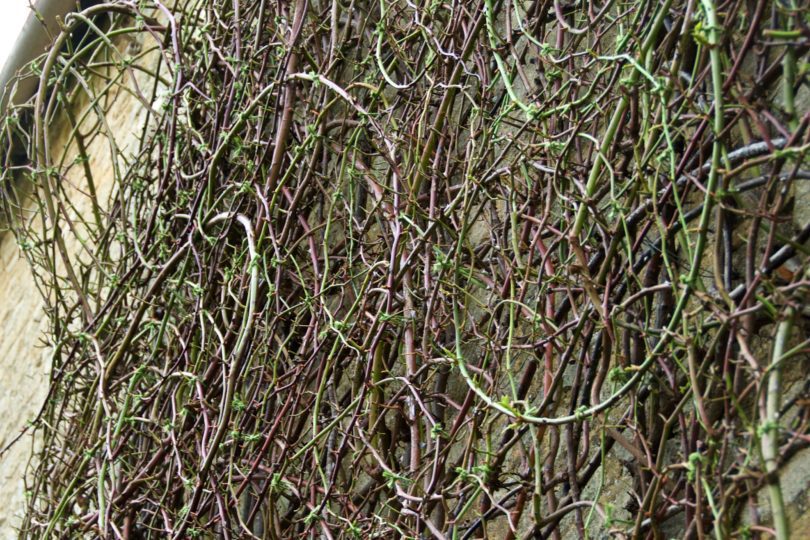
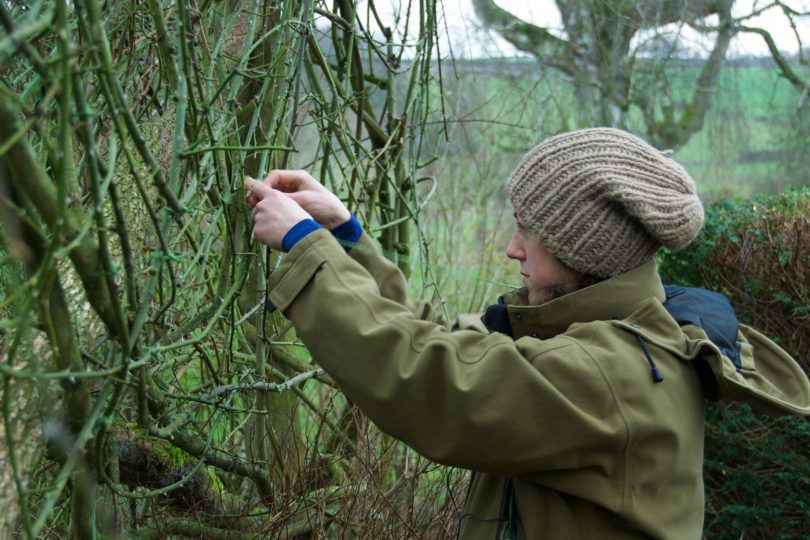
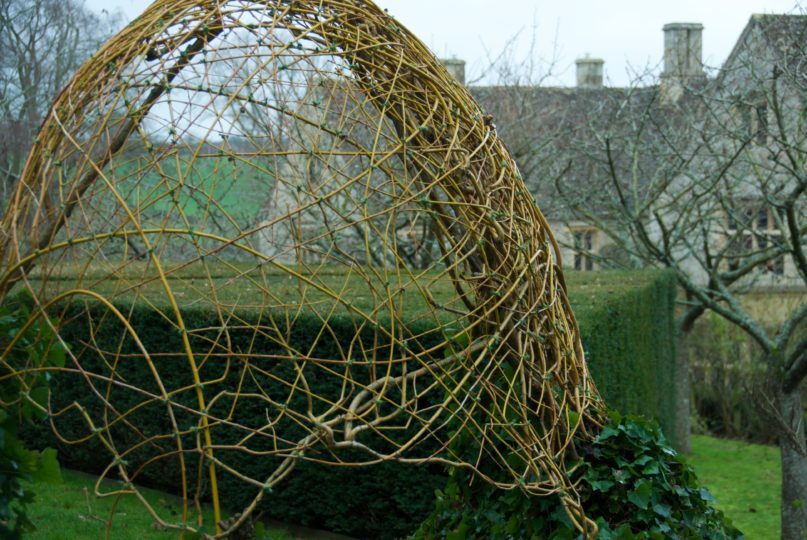



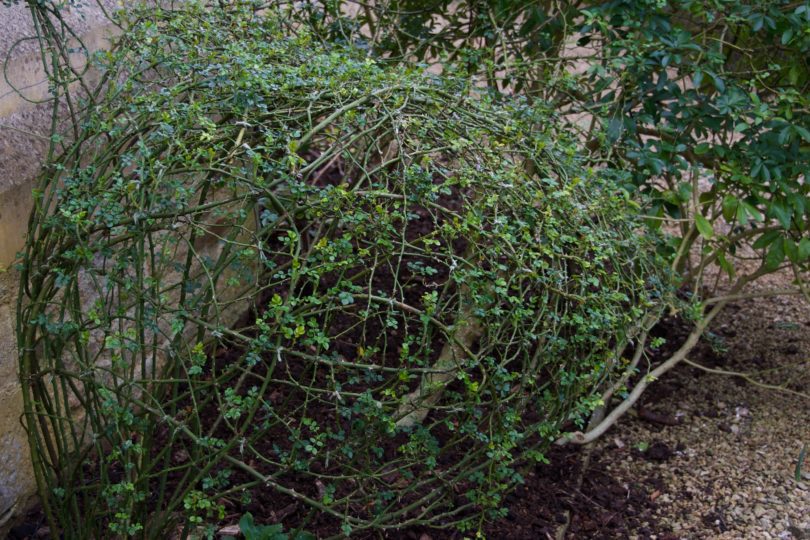
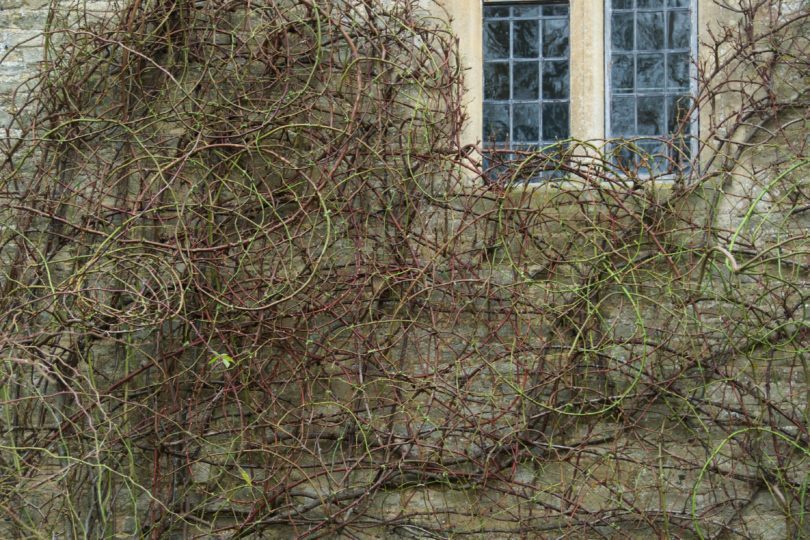

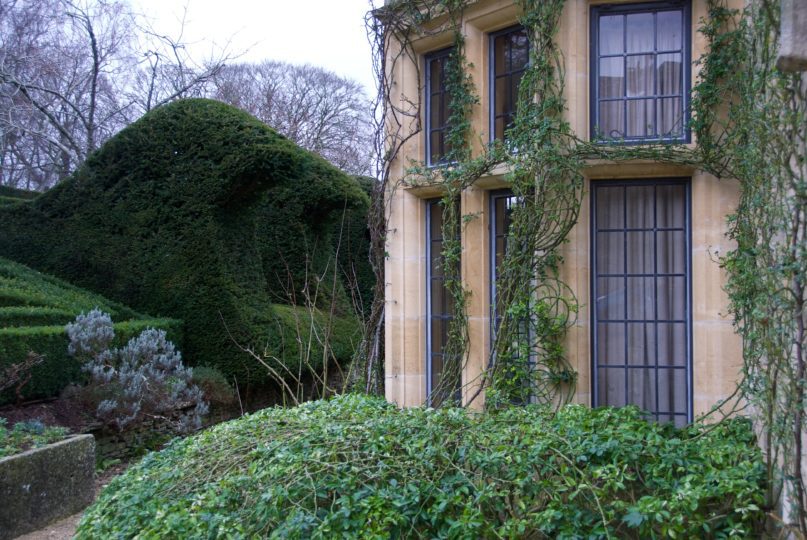

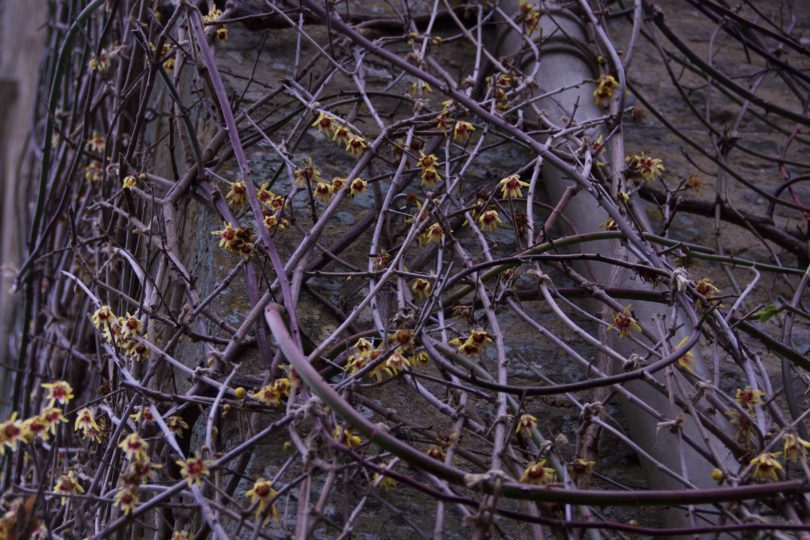
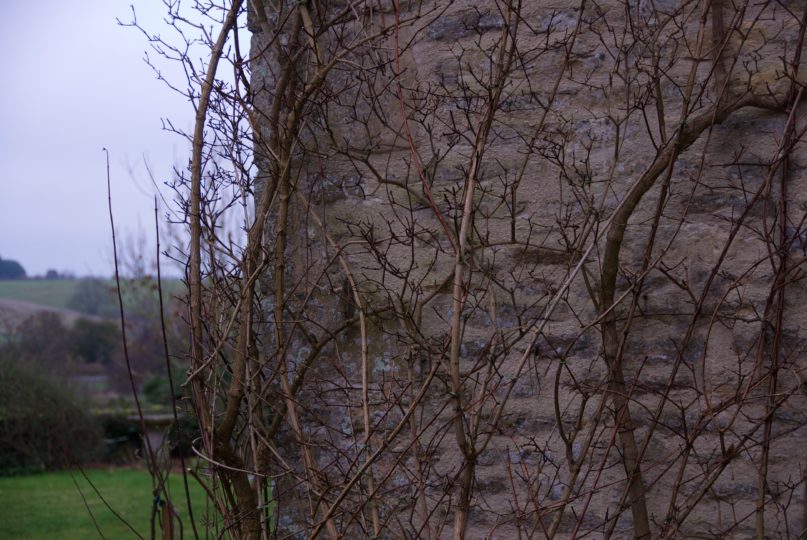
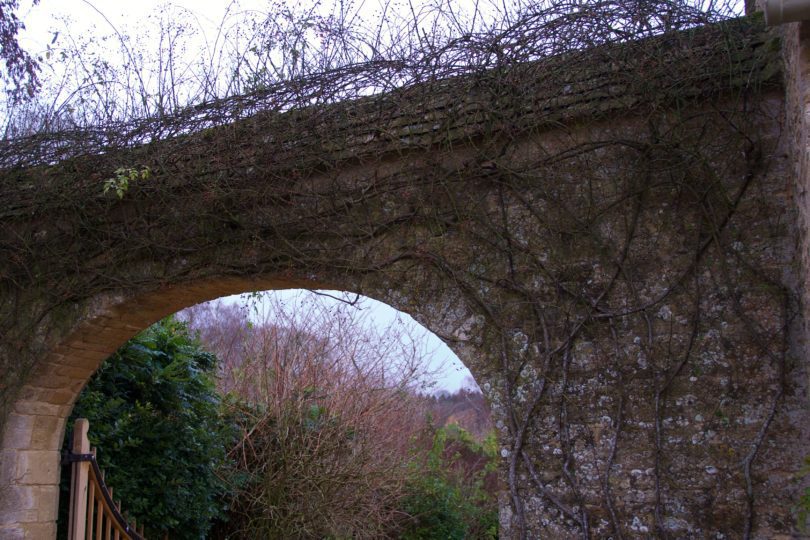
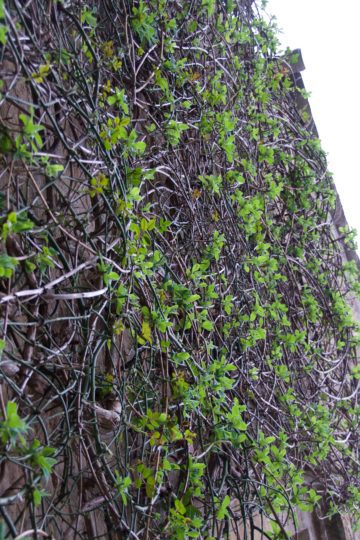

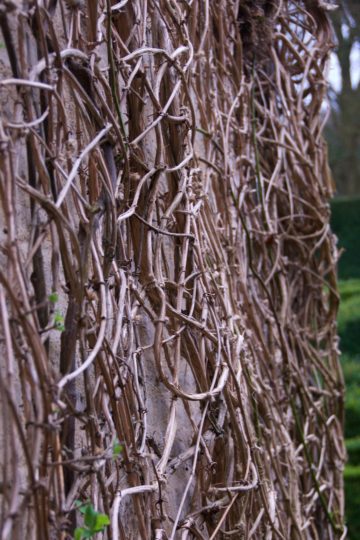
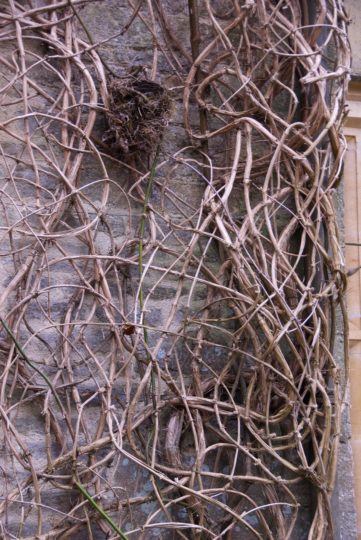
Asthall’s delightful owner Rosie Pearson, explained that the original seed for this technique was ‘loosely’ sown by Julian and Isabel Bannerman. The design duo, famous for their work in the Prince of Wales’ garden at Highgrove, worked their magic on Asthall about 20 years ago. The Bannermans insisted that climbers on the walls must not be cut down hard during winter months, but to leave something there for interest. It was this thought that Mark Edwards, Asthall’s then Head Gardener, developed and embroiled into the 3D marvels of today. And why not indeed? We admire plants not just for their flowers, but for their colour, foliage, texture so why not their stems and branches too?
Not only do the plants look fabulous at this time of the year, but come spring/summer this pruning & tying-in technique pays huge dividends. For roses especially, which rather than limit their floral display to topknots at the end of each stem, blossoms are spread across the plant. Furthermore, by ‘forcing’ the stems and branches into varied directions (horizontal, downward), you are in actual fact slowing down the movement of sap, and the result is more flowers along the stems.
How to prune and weave a la Asthall
Unfortunately for my orange DNA, there are no rules to this technique but there are some helpful guidelines to help you along the way.
- Before you can start anything, you must have a clear view of the material you have to hand. All leaves must therefore be removed. A mammoth task, but oddly satisfying. For one, it’s the only way forward for this technique but you’re also removing leaves that will fall anyway and require picking up afterwards. Furthermore, by their removal you are preventing any fungus diseases from spreading. Do not compost any of the leaves or prunings. Bin or burn is the motto.
- All climbers are then subject to stern traditional pruning. Remove, all the ye oldie dead, diseased and dying material. Mark set the standard here, ‘Nothing brow, nothing dead’. For established shapes, this isn’t the easiest of tasks, but still an absolute must do. Jenny Barnes, current genius Head Gardener at Asthall, has to literally cut holes into many of the structure for access. She limberly climbs in on all fours, to prune away the dead material from within the embroidered mass of branches. As Jenny also advises, don’t be afraid of cutting away too much as you’ll end up with a ‘cleaner’, less fussy shape.
- Start tying in the crossing branches and new growth. Either back to fixed supports and or to neighbouring stems and branches. Use any kind of natural twine and make sure you leave no dangly long bits – a severe no no for Jenny. Stems are tightly tied in, so in effect they don’t rub against each other, so even the RHS should be (sort of) happy. The actual shaping and tying-in process has similarities to cloud/organic pruning techniques as forms are pretty much determined by how the plant wants to grow. The material therefore presents itself, not the other way around. Don’t force branches into strange directions, rather redirect gently from where it naturally can/want to go. The actual shapes, can either be as Jenny’s; tight, neat forms that give the the appearance of flat fluidity. Or, as in Mark’s days; slightly looser, romantic look with drooping branches.
- Most climbers respond well to this technique. Roses are a good candidate, though rambling roses do best on account of their nutter growth rates. Honeysuckle, wisteria, work well but so too do fig trees, quince and even shrubs such as Chimanothus praecox. The varied genera work well on their own, but are also terribly beautiful when intermingled.
- The more mature the plant in question, the ‘easier’ the process, as you’ll have more material to work with. Shapes can take several years to form, as the new growth appears, matures and blends into the overall form. Go with the flow is the order of the day and try not to get too ahead of yourself as to desired shape. The annual pruning cleanse may result in your having to cut out out dead branches that may have been counting on for structure. If so, adapt and move on. Beware of creating shapes that are too top heavy, as even with the sturdiest of ties, the subsequent weight of leaves and blooms can cause it to come away from the wall. Wind, snow can cause damage though as Jenny wisely says, ‘It’s quite nice sometimes when branches or plants die, as it gives you an opportunity to do something else‘. If you’re starting afresh with a young rose, start as you would conventional training, let the branches grow, until you have some stock of material.
- To ensure healthy roses, it’s no surprise that some feed should be given. At Asthall roses are fed with Fish, Blood & Bone and a generous mulching of compost every year.
The garden artist
Jenny’s love for the job is evident throughout. The beautiful shapes, health of the plants and incredible attention to detail do little to hide her enthusiasm for this mammoth annual task. There are over 100 roses at Asthall, each bigger and higher than the next. In addition to the roses, there is wisteria, clematis, figs, willow, chimanothus… All receive the same care and attention. All in sparking condition. All, are shiny billboards of her love for them.
With a degree in forensic science, Jenny once had a plush job working as a gas trader on the national grid. Despite the huge pay cut and parental consternation, she packed it in all in and started working as a gardening apprentice. Not even a grotty garden, with no plants, no colour was enough to deter her. She persevered and completed her year’s apprenticeship. Daylesford in the Cotswolds was her first foray into real gardening, but despite many happy years there as Senior Ornamental Gardener, she still yearned to work in a ‘proper’ garden. A quick peek at ‘Secret Gardens of the Cotswolds‘ defined her future career. On the cover was Asthall Manor and she was in no doubt that this was the garden for her. Within about a month of that epiphany, a job at Asthall came up. She went for the interview, met with Rosie Pearson and Head Gardener Mark Edwards and……. didn’t get the job. Experience shows that Asthall requires physicality and it was initially thought she may not be able to cope. Slopes, hills, meadows, limited access, scale both horizontally as well as vertically make this a beautiful but tough workplace. Fortuitously for Jenny though, the new appointee left, and freed up the role. Working with Mark taught her the ropes, but she quickly started adding her flair to the garden, much evident today. Asthall is a richer garden, with her gardening in it.
If you can, go and see the work for yourself. Asthall Manor is treasure trove of inspiration. I believe you can attend rose pruning courses, which would enable you to learn from the master herself. There’s lots of stuff going on, so do have a look on their website from time to time.
Now admittedly, once the leaves and flowers appear you won’t actually be able to see the degree of intricacy involved in the creation of these beautiful shapes. Some may therefore think it a frivolous exercise and stick to the conventional pruning & training. Personally speaking, there is nothing frivolous about this. We are gardeners for 365 days of the year and adding this beauty when we need it most, is without doubt an exercise, I will dedicate myself to. I also relish the thought, that come spring and summer, knowing that underneath all the blossoming beauty is this beautiful secret sculpture just waiting to reveal itself. Simply wonderful.
